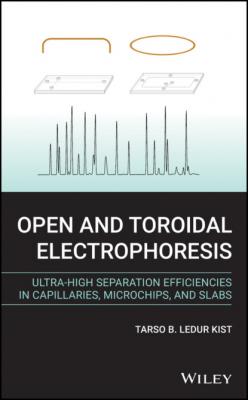ТОП просматриваемых книг сайта:
Open and Toroidal Electrophoresis. Tarso B. Ledur Kist
Читать онлайн.Название Open and Toroidal Electrophoresis
Год выпуска 0
isbn 9781119539247
Автор произведения Tarso B. Ledur Kist
Жанр Химия
Издательство John Wiley & Sons Limited
Figure 1.1 Some neighbors of oxygen in the periodic table. The atomic number is at the upper left, the electronic configuration at the upper right, and the electronegativity [2] at the bottom left. Oxygen has the highest electronegativity of all, except for fluorine. The hydrides shown are: methane, ammonia, water, hydrogen fluoride, silicon hydride, phosphine, hydrogen sulfide, and hydrogen chloride. All are gases in the 0 to 100
1.1.3 Dissolution
Neutral and non-ionizable solutes that are able to form hydrogen bonds tend to be soluble in water. Of course, solubility depends on the size of the molecule, the number of hydrogen bonds each molecule forms with water, the interaction energies of the solute molecules with themselves, and the entropy changes involved. If the number of hydrogen bonds is small and the solute molecules are large compared to the water molecules, then the solute tends to be expelled out from the bulk (interior) of the water by the water molecules. An exact prediction of solubility is given by the Gibbs free energy change (see Section 1.1.8).
1.1.4 Solvation
The introduction of ions into certain solvents makes some solvent molecules attach around these ions, producing one or more layers of solvent molecules. The number of layers mainly depends on the charge of the ions, while the number of water molecules per layer largely depends on the size of the ions. These layers are a result of the charge–permanent dipole interaction between the ions and the permanent dipoles of the solvent molecules. Since water is a small molecule with a large electric dipole moment, this interaction is very strong in water. Figure 1.2 illustrates the solvation of an anion in water and Figure 1.3 illustrates the solvation of a cation in water.
Table 1.1 Relative (static) permittivities of liquids at 20
| Liquid |
|
| N-methylformamide | 189.0 |
| Formamide | 111.0 |
| N-ethylformamide | 104.7a) |
| Water | 80.100 |
| Propylene carbonate | 66.14 |
| Methanoic acid (Formic acid) | 51.1 |
| Dimethyl sulfoxide | 47.24 |
| Glycerol | 46.53 |
| Ethylene glycol | 41.4 |
| N,N-dimethylacetamide | 39.0 |
| N,N-dimethylformamide | 38.25 |
| Acetonitrile | 36.64 |
| 1,3-propanediol | 35.1 |
| Methanol | 33.0 |
| Ethanolamine | 31.94 |
| N,N-diethylformamide | 29.6 |
| 2-pyrrolidone | 28.18 |
| Diethanolamine | 25.75 |
| Ethanol | 25.3 |
| Propan-2-one (Acetone) | 21.01 |
| 1-propanol | 20.8 |
| 2-propanol | 20.18 |
| Allyl alcohol | 19.7 |
| 1-butanol | 17.84 |
| 2-butanol | 17.26 |
| Cyclohexanone | 16.1 |
| Cyclopentanone | 13.58 |
| Trifluoroacetic acid | 8.42 |
| Tetrahydrofuran | 7.6 |
| Ethanoic acid (Acetic acid) | 6.20 |
| Propanoic acid | 3.44 |
| Dimethyl carbonate | 3.087 |
| 1,4-dioxane | 2.2189 |
| Cyclohexane | 2.0243 |
| Hexane | 1.8865 |
a) Calculated considering the change of 0.45% per

